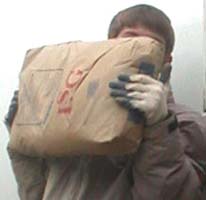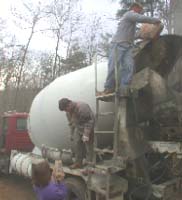ISG Resources, Inc.
Email David Lawrence
When you are building a home you want the best foundation possible.
This is even more critical for my mountain model home and cabin
because the foundation walls are protecting the living areas from the dirt and moisture of the earth berms.
In my research to find products that would make these homes better I made a very interesting discovery, fly ash.
This is a product from burning coal in power plants.
An excellent use has been found for fly ash, strengthening concrete.
In fact most concrete plants add a small amount of fly ash to slow down the curing time during hot weather.
Increasing the proportion can improve the concrete's workability and strength.
It is a good idea for the environment and might even save some cost.
Fly ash can make concrete more durable.
As concrete cures, not all of the lime in the portland cement is used
as a durable binder with the sand or gravel to make the concrete hard.
Then fly ash continues to react with left over lime in the concrete to form calcium silicate hydrate.
This material makes the concrete stronger and less permeable.
The fly ash particles are smaller than the cement, plugging up many of the microscopic voids.
Standard concrete can absorb water because it is so pourous.
Usually water carries with it other chemicals that can break down concrete,
corrode the steel reinforcement, or even pass through into the home.
But fly ash makes it harder for moisture to enter the wall.
This is how fly ash protects the concrete in my walls and floors.
Because fly ash also makes wet concrete flow more easily, less water is needed in the concrete mix.
Even though water is necessary for pouring concrete, it is the enemy of strong concrete.
Less water means more strength, less shrinkage, and less cracking.
Use of fly ash is very good for the environement
because we are taking something that is dumped and using it to replace cement.
Dumping fly ash powder is very bad for the environement.
At this time half of it is disposed of in this manner.
Using fly ash is also good for the environement because cement production
emits tons of carbon dioxide into the atmosphere and consumes enormous quantities of electricity.
Its use can also save money because fly ash prices are often lower
than the cost of the portland cement it is replacing.
To be sure fly ash is added to your concrete, speak with your builder or concrete crew.
They can make sure the concrete plant produces your mix with fly ash.
To learn about this material I spoke with ISG Resources, Inc.
They purchase fly ash from coal plants and sell it to concrete plants.
Every ton they sell means better concrete and less pollution.
For every yard of concrete we added two fifty pound bags of fly ash.
The truck drivers thought we were a little crazy climbing up the ladder with sixteen bags
and dumping them in the back of each of their eight yard trucks.
It was a lot of work, but saved us a couple thousand dollars, made our concrete much better,
and even did something good for the environement.
If you would like more information about this innovative product,
see the top of the page to contact David Lawrence.
SEE OTHER ENTRIES IN OUR HOME DIARY BY
-Bonnie our helpful realtor can be contacted by EMAIL or by phoning her at 800-871-1910
Would you like to see this project under construction?
How to Contact The Mountain Home Show
Appreciation......
This web site contains information obtained from various sources.
The Mountain Home Show is not liable for the accuracy of this information.
Please contact the source of this information with your questions.
 Concrete that is more workable is easier to pour and finish.
Because the fly ash particles are shaped like small spheres they act like tiny ball bearings.
This makes finishing the concrete easier because it can flow better.
Concrete that is more workable is easier to pour and finish.
Because the fly ash particles are shaped like small spheres they act like tiny ball bearings.
This makes finishing the concrete easier because it can flow better.  ISG Resources provided us with all of the fly ash we needed for our model homes.
They recommend we replace twenty percent of the portland cement with fly ash.
By mistake we added the fly ash without reducing the portland cement.
We saved a lot of concrete costs because the fly ash increased the volume so much,
making the concrete go 20 percent further.
We could have saved even more if we reduced the portland cement because that ingredient
is what makes concrete expensive.
We ended up with concrete that is much stronger than we anticipated.
ISG Resources provided us with all of the fly ash we needed for our model homes.
They recommend we replace twenty percent of the portland cement with fly ash.
By mistake we added the fly ash without reducing the portland cement.
We saved a lot of concrete costs because the fly ash increased the volume so much,
making the concrete go 20 percent further.
We could have saved even more if we reduced the portland cement because that ingredient
is what makes concrete expensive.
We ended up with concrete that is much stronger than we anticipated.
CLICKING ON THE FOLLOWING LINKS:
(These will be updated throughout the project).
 Back to the Diary Home Page
Back to the Diary Home Page
 Step 1, Purchasing the Land
Step 1, Purchasing the Land
 Step 2, Designing Our Own Home
Step 2, Designing Our Own Home
 Step 3, Our Septic Permit
Step 3, Our Septic Permit
 Step 4, Our Insulated Wall System
Step 4, Our Insulated Wall System
 Step 5, Cutting Lumber from Our Own Trees
Step 5, Cutting Lumber from Our Own Trees
 Step 6, Plumbing Before the Slab is Poured
Step 6, Plumbing Before the Slab is Poured
 Step 7, Pouring the Concrete Floors
Step 7, Pouring the Concrete Floors
 Step 8, Pouring Concrete in the ICF Walls
Step 8, Pouring Concrete in the ICF Walls
 Step 9, Framing the Wood Walls, Floors, and Roof
Step 9, Framing the Wood Walls, Floors, and Roof
 Step 10, Installing the Windows
Step 10, Installing the Windows
 Step 11, Roughing in Plumbing and Electrical
Step 11, Roughing in Plumbing and Electrical
 Step 12, Insulation
Step 12, Insulation
 Step 13, Roofing Our Home
Step 13, Roofing Our Home
 Step 14, Finishing the Cabin
Step 14, Finishing the Cabin
I have friends in the construction industry who are very interested in this home.
In appreciation for their assistance, I would like to give them credit for their help,
and give you the opportunity to contact them.
The following list will be updated regularly:
-Tony of A&L Construction did the clearing, excavating, and sawed lumber from our trees. He can be reached at 828-835-9926.
-Pete is a very good part time carpenter. You can phone him at 828-479-9458.
Come to the next Mountain Home Show, and you will get an invitation to our open house.
For more informaiton, click on the link to "Detailed information about the home show."
If you are interested in building, you may also be able to make an appointment to visit.
Click on "Email Richard" to make an appointment.
Or perhaps you would like to observe the construction of this home on line.
Click on "Construction Diary."
You are welcome to visit often as we continually update it.
How to Contact Richard C. MacCrea
 My Facebook Page
My Facebook Page
(Design news and ideas)
Email Me
(Opens an email window)
800.738.8781 P.O. Box 446, Murphy, North Carolina 28906
Other Pages on this Web Site
 The Mountain Home Show, Home Page and Site Map
The Mountain Home Show, Home Page and Site Map
(How to find what you're looking for)
The Next Mountain Home Show Program
(For guests and exhibitors)
How to Get in The Mountain Home Show
(For exhibitors)
Articles
(About designing, building and remodeling a mountain home)
The Mountain Model Home
(A home that experiments with extreme energy efficiency)
The Mountain Model Cabin
(A cabin that experiments with small size and energy efficiency)
Construction Diary
(The joys and frustrations of building these two model homes)
Home Designing and Planning
(How to get plans for building or remodeling your home)
 Email Us
Email Us
(Opens an email window)
Like our Facebook Page
(Join our Mountain Home Show Community for news and contacts)
The Mountain Home Show, P.O. Box 446, Murphy, North Carolina 28906-0446
The Mountain Home Show owes its success to the businesses that participate in the show.
They arrange such wonderful exhibits.
It is obvious that they take great pride in their work and our show.